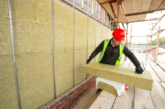
Scott Wolters, UK Building Product Sales Director at EGGER UK explains how you can better protect your workforce and prevent slips and trips on site.
Slips and trips account for the largest cause of injuries in the UK construction industry, with workplace injury and ill health costing the country around £20.7 billion per year.
With this, it’s clear that more needs to be done to protect workforces on active housebuilding sites, and that teams need to be provided with safe working platforms. Here, Scott Wolters, UK Building Product Sales Director at EGGER UK, takes a closer look… Of all the industries in the UK, construction has the highest number of fatal injuries, with the majority of these coming from falls from height. With this in mind, it’s critical that housebuilders take steps to ensure the safety of their teams on site, including the careful consideration of any specification choices.
A fundamental part of any housebuilding project, structural flooring will often be installed early on in the construction process, generally before the building has been made watertight. As a result, the flooring often serves a secondary function as a working platform for weeks or even months, providing site teams and subcontractors with the means to carry on other works around them. In addition to having to withstand daily site traffic and dropped tools or material spillages, the flooring is also likely to be exposed to the elements, posing a potential slip risk for the workforce.
When specifying structural flooring for a job, the focus will often be placed on its durability, performance, cost and sustainability. However, given its secondary use as a working platform, it is evident that housebuilders should also be checking a structural flooring product for its slip potential. It’s therefore important to understand what you should be looking for in terms of product ratings and the types of testing that flooring undergoes to achieve these ratings.
The predominant test for structural flooring and its slip resistance is the Pendulum Test, which provides a Pendulum Test Value (PTV). Widely used across the UK, a Pendulum Test evaluates the way a shoe or foot will react to a surface, in both damp and dry conditions.
The pendulum itself acts as the shoe or foot and is swung from height in an arched motion across the sample being tested. The highest height this pendulum reaches after touching the surface is then recorded as the PTV. This pendulum is intended to simulate a worker’s boot crossing over the surface, providing an accurate result for slip resistance.
All structural flooring is tested against this system under BS-7976-2, with a value of 36 or more resulting in a Low Slip Potential being assigned to the product, as seen with EGGER Protect. A value of between 24 and 35 is calculated as a Moderate Slip Potential and under 24 has a High Slip Potential, with anywhere from a 1 in 20 to a 1 in 200 chance of a slip occurring at this level.
Whilst most structural flooring boards on the UK market achieve a Moderate rating, EGGER remains the reliable manufacturer of a chipboard-based structural flooring board that is verified as Low Slip Potential in Wet Conditions, in accordance with the Health and Safety Executive’s (HSE) guidance for assessing the slip resistance of flooring.
EGGER Protect is a high-quality structural flooring board, thermally bonded on both sides to ensure protection from moisture and engineered to withstand tough site conditions. It has achieved the highest class of slip resistance, with a Pendulum Test Value (PTV) of 40 in wet and 55 in dry conditions – independently tested and verified by a UKAS accredited laboratory.
Providing a 60-day safe solution, which can be fitted in light rain conditions, EGGER Protect significantly minimises the chance of accidents and injuries on site.








